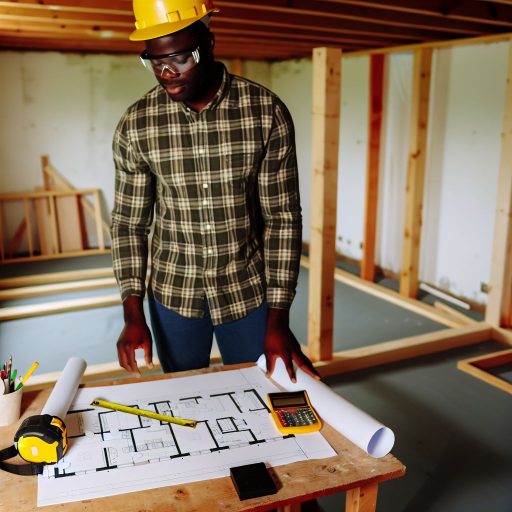Introduction to Renovation Cost Estimation
Renovation cost estimation is crucial for real estate projects.
Homeowners and investors must understand the costs involved.
Accurate estimates help in budgeting and financial planning.
This guide provides an overview of the estimation process.
Understanding the Importance
Knowing renovation costs prevents financial surprises.
It allows stakeholders to weigh renovation options effectively.
Moreover, a detailed estimate increases negotiation power.
Estimates can also enhance project feasibility assessments.
Components of Renovation Costs
Construction labor costs form a significant part of estimates.
Materials are another major expense to account for.
Permits and fees often add unexpected costs to the total.
Design costs, such as architectural consultations, should also be included.
Finally, don’t forget the costs of potential delays.
Overview of the Estimation Process
The first step is to determine the project scope.
Next, gather labor and material cost data specific to the area.
Then, create a detailed list of all project components.
Use historical data and expert consultations for accuracy.
Review and adjust estimates as necessary based on new information.
Factors Influencing Renovation Costs
Location
The geographic location significantly impacts renovation costs.
Regions with high demand often see increased prices.
Urban areas typically have higher labor and material expenses.
In contrast, rural locations may offer lower costs.
Local building codes and regulations can also vary.
Adhering to these can influence your budget substantially.
Scope
The extent of work required directly affects costs.
Minor renovations tend to cost less than major overhauls.
Consider if you’re upgrading, updating, or fully remodeling.
Each of these choices requires a different financial commitment.
For example, kitchens and bathrooms usually carry higher expenses.
Furthermore, structural changes will add to labor costs.
Materials
The quality of materials chosen will impact overall expenses.
Higher-end finishes and fixtures can significantly raise costs.
Conversely, opting for budget-friendly options can reduce your bill.
Research various suppliers for competitive pricing.
Selecting durable materials may save money in the long run.
Additionally, consistent sourcing can ensure cost-efficiency.
Types of Renovations: Cosmetic vs. Structural and Their Cost Implications
Understanding Cosmetic Renovations
Cosmetic renovations focus on aesthetic improvements.
These changes enhance the property’s appearance without major structural work.
Examples include painting, flooring updates, and kitchen backsplashes.
Costs for cosmetic renovations are generally lower than structural changes.
Homeowners can often complete these projects themselves to save money.
However, hiring professionals can ensure a polished finish.
On average, cosmetic renovations can cost between $5,000 to $20,000.
Exploring Structural Renovations
Structural renovations involve changes that affect the building’s framework.
These include adding or removing walls, foundations, or electrical work.
Such projects are often more expensive and time-consuming.
For instance, adding a room or remodeling a basement can greatly increase costs.
Homeowners should budget significantly more for structural renovations.
Costs can range from $20,000 to well over $100,000.
Comparative Cost Analysis
When deciding between cosmetic and structural renovations, consider your budget.
Cosmetic updates may create a refreshed look without overwhelming expenses.
Alternatively, structural renovations can drastically change your living space.
They often increase property value but require more substantial financial investment.
Keep in mind the potential return on investment for each type.
Evaluate local market trends for better financial planning.
Making Informed Decisions
Consider your goals for the renovation before proceeding.
Cosmetic renovations suit homeowners seeking immediate aesthetic benefits.
In contrast, structural changes may be necessary for long-term usability.
Always weigh your options carefully to ensure you make informed decisions.
Consult with a renovation expert to guide you through the process.
Gain More Insights: Renovation Cost Estimation for Increasing Home Resale Value
Estimation Techniques
Introduction to Cost Estimation
Cost estimation is vital for successful renovation projects.
It helps homeowners budget effectively and allocate resources wisely.
Moreover, accurate predictions can prevent financial overruns.
Common Estimation Methods
There are several established methods to estimate renovation costs.
Each method has its own advantages and limitations.
Unit Cost Method
The unit cost method involves calculating costs per unit.
This method simplifies estimation for contractors.
Contractors can use historical data for accuracy.
However, variability in project specifics may affect results.
Task-Based Estimation
Task-based estimation breaks down the project into specific tasks.
Estimators calculate costs for each task individually.
This method provides a detailed view of project expenses.
On the downside, it requires extensive project knowledge.
Labor and Materials Estimation
Material and labor estimation focuses on direct costs.
Estimators calculate the quantity and cost of materials needed.
They also consider labor rates for different trades.
This method demands current pricing data for accuracy.
Using Software Tools
Many professionals utilize software for cost estimation.
These tools streamline calculations and improve accuracy.
Some platforms also integrate design and cost functions.
Examples include CoConstruct, Buildertrend, and PlanSwift.
Importance of Regional Variations
Cost estimations vary across different U.S. regions.
Labor rates, material costs, and regulations differ significantly.
It’s essential to account for local market conditions.
Consulting local experts can enhance estimation accuracy.
Factors Influencing Renovation Costs
Many factors can impact renovation costs.
These include project size, scope, materials, and labor availability.
Additionally, the home’s age and condition can affect expenses.
Mainly, unexpected issues during renovations may lead to budget increases.
Finalizing the Estimate
Finalize your estimate after gathering all relevant data.
Review the estimates with professionals involved.
Comparison with previous projects can provide additional insights.
Lastly, ensure a contingency fund for unexpected costs.
Explore Further: Evaluating Modern Home Renovation Trends To Enhance Investment Portfolios
Creating a Renovation Budget
Key Components of a Renovation Budget
A renovation budget requires careful planning and organization.
Firstly, assess the scope of the renovation project.
This includes determining the type of changes you want to make.
Key areas often involve kitchens, bathrooms, and living spaces.
Next, estimate costs for materials and labor.
Prices can vary widely based on quality and local market conditions.
Engage with local contractors for accurate quotes and timelines.
Moreover, factor in additional costs such as permits and inspections.
Consider the costs of potential design services or consultations.
Finally, compile a list of all anticipated expenses.
Contingency Funds for Unexpected Costs
It’s crucial to prepare for unexpected expenses during renovations.
Establish a contingency fund, typically 10-20% of your total budget.
This fund will cover unforeseen issues that may arise.
Common surprises include structural repairs or outdated plumbing.
Moreover, keep your contingency fund separate from other budget components.
Doing so will help prevent overspending during the renovation process.
Monitor your expenditures closely to ensure sustainability.
Prioritizing Your Renovation Needs
Start by identifying which areas of your home need immediate attention.
Develop a list of priorities based on essential repairs and upgrades.
Focus on improvements that offer the best return on investment.
For instance, consider upgrading outdated kitchens or bathrooms.
Subsequently, refine your budget based on these priorities.
Always remain flexible to shift funds if issues arise.
This approach helps maintain control over your renovation project.
Monitoring and Adjusting Your Budget
Continuous monitoring of your renovation budget is vital.
Track spending and remain aware of how it aligns with your budget.
Set up regular check-ins to review financial progress.
Adjust your budget when necessary, particularly if costs exceed estimates.
Encourage open communication with contractors regarding expenses.
Consider using budgeting software to assist in tracking your finances.
This tool can simplify adjustments and highlight areas needing attention.
Uncover the Details: Understanding Material Impact In Renovation Cost Estimation For U.S. Homes

Utilizing Professional Services
When to Hire Contractors
Hiring contractors can streamline your renovation process.
Consider hiring professionals for complex projects.
For example, structural renovations typically require expert guidance.
Additionally, specialized tasks like electrical work should be left to licensed contractors.
Assess the scope of your renovation to determine your needs.
If tasks exceed your skill level, it’s time to seek help.
Understanding Their Impact on Costs
Contractors can influence your overall renovation budget.
While they may seem costly, their expertise can save money in the long run.
Professionals help avoid costly mistakes that DIY projects might incur.
Moreover, they often have access to discounts on materials.
This can significantly reduce your material costs.
Consult multiple contractors to compare estimates.
Ensure you receive detailed quotes to understand all expenses involved.
Finding Reliable Contractors
Start by asking for recommendations from friends or family.
Online reviews can also guide you to reputable professionals.
Check credentials and licenses before making a decision.
Schedule interviews with potential contractors to discuss your project.
This allows you to gauge their expertise and communication skills.
Establishing Clear Communication
Set clear expectations from the beginning of the project.
Discuss timelines and any potential delays upfront.
Regular updates from contractors can keep you informed.
Establishing open lines of communication fosters a better working relationship.
Don’t hesitate to voice concerns — clarity is key to a successful renovation.
Evaluating Your Budget
Identify your budget before hiring professionals.
Include all potential costs, such as materials and labor.
Always set aside a contingency fund for unexpected expenses.
A budget can help you make informed decisions while hiring contractors.
Prioritize essential renovations that will add value to your property.
Gain More Insights: Eco-Conscious Homeowners’ Guide to Sustainable Renovation Materials
Common Renovation Mistakes: Avoiding Budget Overruns and Delays
Underestimating Costs
Many homeowners fail to accurately estimate renovation costs.
This often results in unexpected expenses.
Ultimately, this can lead to budget overruns.
To avoid this, create a detailed budget plan.
Include a contingency fund of 10-20% for unforeseen costs.
Lack of Planning
Insufficient planning can cause delays and chaos.
Make sure you define clear goals for your renovation.
A well-thought-out timeline helps maintain momentum.
Moreover, securing necessary permits beforehand is crucial.
Ignoring Professional Help
Some homeowners try to do everything themselves.
This can lead to mistakes that are costly to fix.
Consider hiring professionals for specialized tasks.
For instance, certified electricians ensure safety and compliance.
Additionally, experienced contractors can improve efficiency.
Overpersonalizing Your Space
While personal touches are important, avoid extreme customization.
This can affect the property’s resale value.
Instead, opt for neutral choices that appeal to a broader audience.
Keep in mind that renovations should attract future buyers.
Forgetting About Permits and Regulations
Many renovations require specific permits by law.
Neglecting this can result in fines or project halts.
Always check local regulations before starting a project.
Consulting with local authorities can prevent legal issues.
Failing to Communicate
Effective communication is essential during renovations.
Keep an open line with your contractors and team members.
Regular updates help address issues before they escalate.
Moreover, this ensures everyone is aligned on progress and expectations.
Case Studies: Analyzing Renovation Projects and Their Budget Outcomes
Project Overview: The Smith Residence
The Smith family undertook a major renovation in their suburban home.
They aimed to modernize the kitchen and expand the living area.
Initially, their budget was set at $75,000.
Key Renovation Elements
- Full kitchen remodel, including new cabinets and countertops.
- Addition of a sunroom for increased living space.
- Outdoor landscaping to enhance curb appeal.
Budget Breakdown
The kitchen renovation accounted for 60% of the total budget.
New cabinets and appliances added significant costs.
The sunroom addition consumed around 30% of the budget.
Landscaping expenses were minimal, comprising 10% of costs.
Outcome Analysis
Ultimately, the total project exceeded the budget by $10,000.
Unexpected structural issues arose during the renovation.
However, the Smiths reported increased home value afterward.
Project Overview: The Johnson Duplex
The Johnsons renovated a duplex for rental purposes.
They focused on updating both units with modern amenities.
The budget was initially set at $100,000.
Key Renovation Elements
- Complete overhaul of electrical and plumbing systems.
- Kitchen upgrades with energy-efficient appliances.
- Bathroom remodels in both units for increased appeal.
Budget Breakdown
Electrical and plumbing upgrades were the largest expense.
The kitchen renovations represented a significant investment.
Bathroom updates were completed under budget due to careful sourcing.
Outcome Analysis
The renovation was completed on time and within the original budget.
Rental income increased by 25% post-renovation.
The Johnsons successfully attracted higher-quality tenants.
Project Overview: The Garcia Family Home
The Garcias focused on energy-efficient renovations.
They wanted to reduce their utility bills significantly.
The planned budget was $50,000.
Key Renovation Elements
- Installation of solar panels on the roof.
- Upgrading insulation throughout the house.
- Replacing old windows with energy-efficient models.
Budget Breakdown
Solar panel installation took up a majority of the budget.
Insulation upgrades were cost-effective and essential.
New windows were a worthwhile investment for energy savings.
Outcome Analysis
The project finished right on budget with $500 left over.
The Garcia family now enjoys reduced monthly utilities.
Additionally, government incentives boosted their savings.




